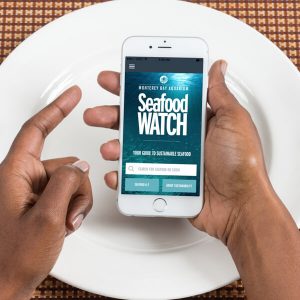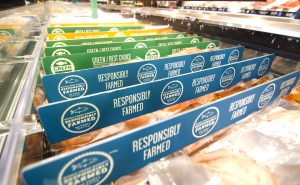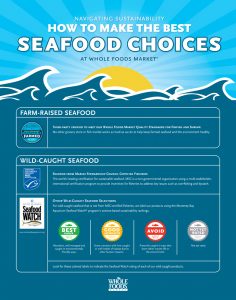According to Oceana, 80% of the world’s oceans are being over-exploited. Overfishing is has turned to be one of the major concerns of recent decades: fish populations decline without the ability to bounce back when demand overrides a fish’s capability to reproduce. Another contribution to overfishing is bycatch—marine animals that are caught unintentionally in nets and bottom trawls.
By trying to understand what I could potentially do as a consumer, I came across two initiatives which I consider utterly interesting. The first one is an application called the SeaFood Watch. This application helps you choose ocean-friendly seafood at your favorite restaurants and stores. The way it is designed makes it attractive and useful to get the latest recommendations for seafood and sushi, learn more about the seafood you eat, and locate or share businesses that serve sustainable seafood. Likewise, the second initiative is the fact that Whole Foods offers sustainability rankings by labeling its seafood products as either “best choice,” “good alternative” or “avoid.” All seafood is color-coded as “best choice” (green), “good alternative” (yellow) or “avoid” (red). Factually, I believe both programs are great examples of two concepts we discussed in class: convenience and partnerships for sustainability.


On the one hand, SeaFood Watch converts the process of learning and recognition of sustainable and non-sustainable options a more comfortable and less time-consuming practice for the consumer. In terms of partnerships, the creators of this App – Monterey Bay Aquarium – collaborate with a large number of business and organizations. The partners get access to SeaFood’s data sets, reports and updates; the possibility to use SeaFood’s logo for messaging their commitment; networking opportunities with other partners; educational tools and recognition of their efforts in SeaFood’s web and social media. At the same time, Monterey Bay Aquarium requires the collaborators to make a commitment to identify environmentally responsible recommendations on all product listings and provide accurate Seafood Watch information to all customers.

On the other hand, Whole Foods’ initiative started out this labeling project in conjunction with Blue Ocean and SeaFood Watch. In my opinion, this partnership does not only provide the supermarket with environmental tools and knowledge. It is actually also really strategic in terms of marketing: they reinforce their responsible reputation by showing their green partners and better target their conscientious consumers by showing their concerns regarding ecological issues. Apart from that, convenience is as well enhanced by easing consumer’s sustainable decisions.


Such a relevant topic! Our poor oceans are so vulnerable! From harmful waste making its way to the bodies of water, to reckless fishing, we really have to change our habits fast. I read an article recently and it said that if we humans continue to use plastics like we do, there will be more plastics in our oceans than fish by 2050! That is really scary! I liked the initiatives you highlighted in this piece. I am especially intrigued in the Whole Foods labelling system. I find it interesting that a company who prides itself in supplying wholesome foods, would even sell a fish product that they label “Avoid”. I can only hope their motive behind this is to encourage those companies to change their ways. This could be an interesting tactic to apply across the food industry altogether. I wonder if we can “scare” companies into doing better… food for thought (pun totally intended)!
Hello Nuria,
As someone who consumes fish on a weekly basis, I think that the SeaFood Watch and Whole Food’s initiatives could help me become a more conscious buyer. However, I do think that both organizations have to improve their strategy when it comes to marketing these initiatives. I buy tuna quite frequently and I was not aware of SeaFood Watch until I came across this post. The technology is already there; all they have to do is get consumers to use it. That is why I think that they should advertise their app on the packaging or perhaps get retailers to promote it within their store.